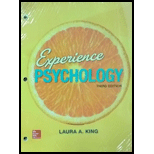
Correct answer:
The correct answer in this case is option (B), discriminates between different groups.
Explanation of Solution
Reason for the correct statement:
An empirically keyed test asks the same questions to two different groups that are known to be different. The test items are not related to what the researchers are studying. Therefore, by doing this, personality researchers can overcome the problem of social desirability in self-report testing.
Reasons for the incorrect statements:
Option (A) refers to empirically keyed tests having right or wrong answers. By nature, self-report tests have no right or wrong answers. These tests simply describe a person’s preferences. So, option (A) is incorrect.
Option (C) refers to empirically keyed tests having face validity. Empirically keyed tests do not relate to the research question on the surface, so they don’t have face validity. So, option (C) is incorrect.
Option (D) refers to empirically keyed tests having both easy and difficult questions. Since self-report tests are merely asking respondents to share details about themselves, all questions should be fairly simple to answer. So, option (D) is incorrect.
Therefore, the options (A), (C), and (D) are incorrect.
Personality researchers use empirically keyed tests to help distinguish between two groups that are known to be different. Using this technique helps them overcome the issue of social desirability that occurs with self-report tests.
Want to see more full solutions like this?
Chapter 10 Solutions
Experience Psychology, 3rd edition
- I need help with this assaigmentarrow_forwardI need help with this assignment I need to find at least 30 preferences for nonconformity for this research question Can having certain body modifications increase or decrease your chances of attracting a mate? That can work for a survey questionarrow_forwardI need help finding at least four nonconformity variable survey questions for this research question can having certain body modifications increase or decrease your chances of attracting a matearrow_forward
- I need help finding pictures of people with piercings and tattoos an i also need people with out them as well I need a white person , black person an a mexican person. But the picture has to be the same person with tattoos an piercing but also with out them as well.arrow_forwardHow do I write an argumentative essayarrow_forwardWhat motivates and excites you about working specifically with children on the autism spectrum? Have you had any experiences or personal encounters that inspired your interest in this field?arrow_forward
- How might social work research inform dialogue on efforts to reform the immigration system? Please cite in text source and list referencesarrow_forwardSsw 3010 care of plan case study B Tyronearrow_forwardHow does music influence your emotions? Can you recall a specific song or piece of music that has evoked strong emotions in you? What was it about that music that elicited such a response? Song: See You Again - Wiz Khalifa Instructions: 1) Recall a song that evoked strong emotions 2) What emotions did the song help you feel? and why? 3) Are there specific musical elements (e.g., melody, rhythm, harmony, lyrics) that you find particularly powerful in shaping emotional experiences? How do these elements contribute to the overall emotional impact of a piece of music?arrow_forward
- How does music influence your emotions? Can you recall a specific song or piece of music that has evoked strong emotions in you? What was it about that music that elicited such a response? Instructions: - Recall a song that evoked strong emotions - What emotions did the song help you feel? and why? - Are there specific musical elements (e.g., melody, rhythm, harmony, lyrics) that you find particularly powerful in shaping emotional experiences? How do these elements contribute to the overall emotional impact of a piece of music?arrow_forwardHow can social workers contribute to prison or criminal justice reform efforts and initiatives? Please cite in text source and list references.arrow_forwardCriminological theory support drunk driving appropriatenessarrow_forward
 Ciccarelli: Psychology_5 (5th Edition)PsychologyISBN:9780134477961Author:Saundra K. Ciccarelli, J. Noland WhitePublisher:PEARSON
Ciccarelli: Psychology_5 (5th Edition)PsychologyISBN:9780134477961Author:Saundra K. Ciccarelli, J. Noland WhitePublisher:PEARSON Cognitive PsychologyPsychologyISBN:9781337408271Author:Goldstein, E. Bruce.Publisher:Cengage Learning,
Cognitive PsychologyPsychologyISBN:9781337408271Author:Goldstein, E. Bruce.Publisher:Cengage Learning, Introduction to Psychology: Gateways to Mind and ...PsychologyISBN:9781337565691Author:Dennis Coon, John O. Mitterer, Tanya S. MartiniPublisher:Cengage Learning
Introduction to Psychology: Gateways to Mind and ...PsychologyISBN:9781337565691Author:Dennis Coon, John O. Mitterer, Tanya S. MartiniPublisher:Cengage Learning Psychology in Your Life (Second Edition)PsychologyISBN:9780393265156Author:Sarah Grison, Michael GazzanigaPublisher:W. W. Norton & Company
Psychology in Your Life (Second Edition)PsychologyISBN:9780393265156Author:Sarah Grison, Michael GazzanigaPublisher:W. W. Norton & Company Cognitive Psychology: Connecting Mind, Research a...PsychologyISBN:9781285763880Author:E. Bruce GoldsteinPublisher:Cengage Learning
Cognitive Psychology: Connecting Mind, Research a...PsychologyISBN:9781285763880Author:E. Bruce GoldsteinPublisher:Cengage Learning Theories of Personality (MindTap Course List)PsychologyISBN:9781305652958Author:Duane P. Schultz, Sydney Ellen SchultzPublisher:Cengage Learning
Theories of Personality (MindTap Course List)PsychologyISBN:9781305652958Author:Duane P. Schultz, Sydney Ellen SchultzPublisher:Cengage Learning





